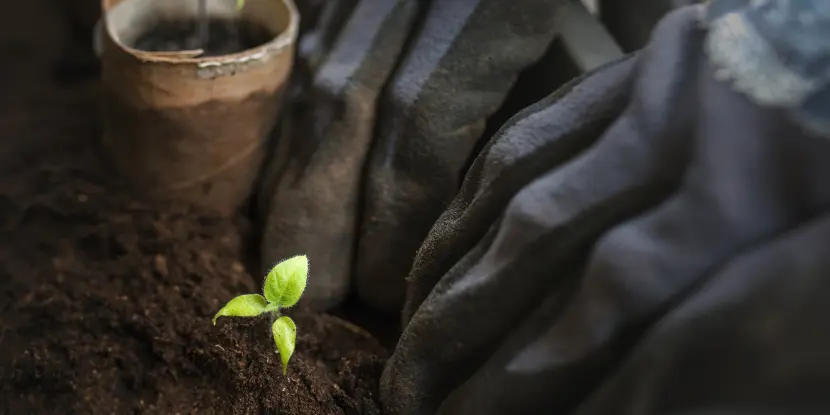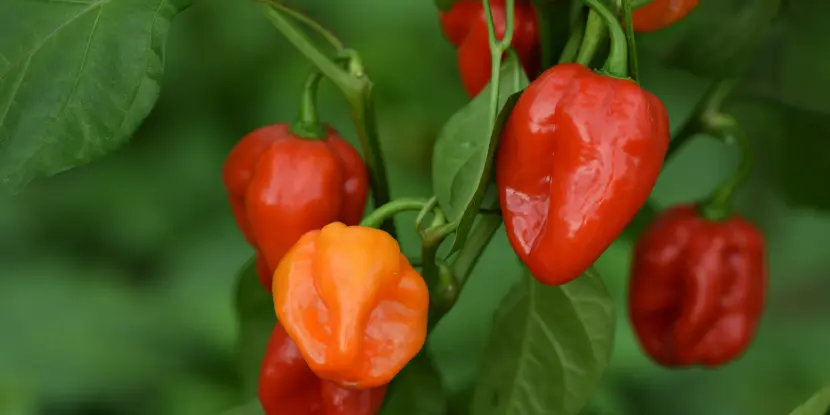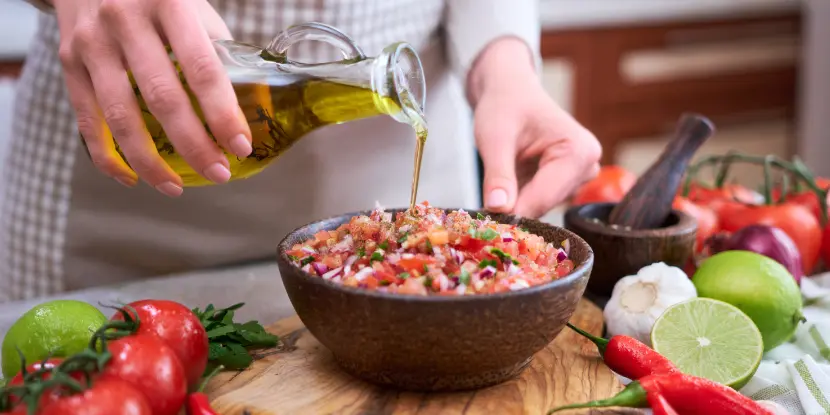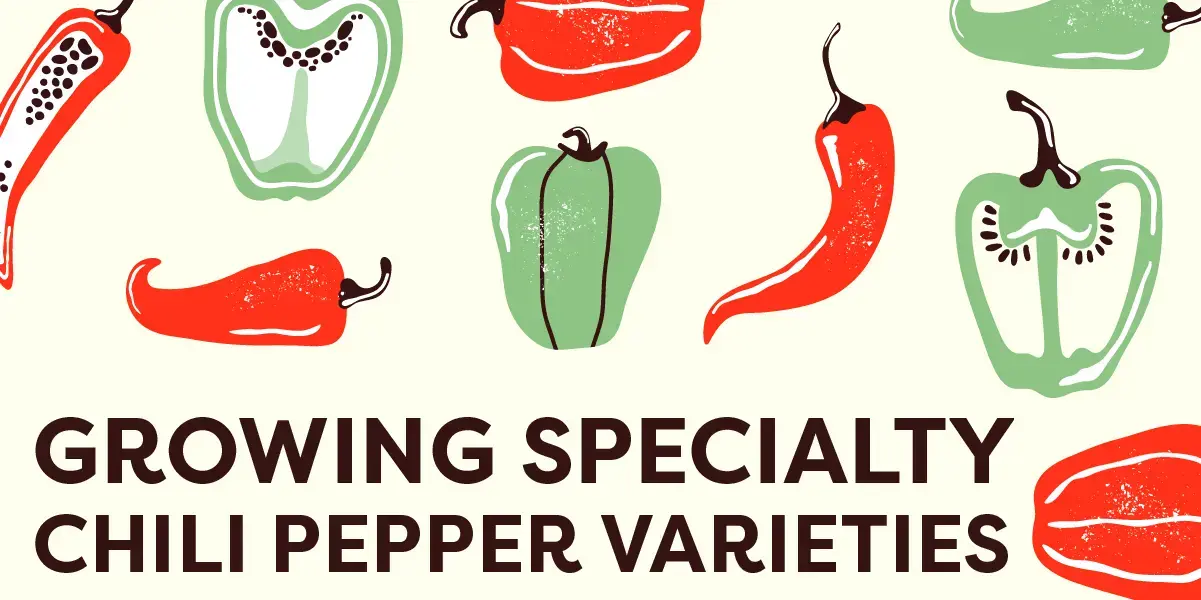Are you looking to spice up your life?
We’re not talking about lingerie, but peppers. Chile peppers, to be exact, some of which are hot enough to strip the bark off a tree. But oh-so-tasty!
In this blog, we’ll cover some of the less-appreciated Caribbean varieties that work so wonderfully in sauces. And we’ll post a few recipes to launch your culinary journey.
Understanding the Scoville Heat Unit (SHU)
The Scoville Heat Unit, or SHU, quantifies a pepper’s capsaicin content. Capsaicin is the chemical responsible for a chile pepper’s “heat.”
Developed in 1912 by pharmacist Wilbur Scoville, the Scoville Scale ranges from 0 (bell peppers) to over 2 million (Carolina Reaper, one of the hottest peppers in the world). The higher the SHU rating, the hotter the pepper.
This scale lets you gauge the heat level of peppers and therefore, the Caribbean dish you may be serving for dinner.

The Scoville Scale for chiles: measuring heat.
Caribbean Pepper Varieties (from mildest to hottest)
Cubanelle Pepper
A staple in Caribbean and Italian cooking, the Cubanelle Pepper has mild heat and a sweet, slightly tangy flavor. The fruit is long and tapered, with a bright green color that matures to red or yellow. It’s perfect for frying, stuffing, or an accent in salads.
- 100 – 1,000 SHU.
- Mildly spicy, making it suitable for a wide range of dishes.
- Sweet with a hint of tanginess.
- Thrives in warm climates and full sun.
Cascabe Morado Pepper
This dark-purple pepper is a visual standout in any garden or dish. The Cascabe Morado delivers moderate heat that lingers pleasantly without overwhelming the palate.
- 1,500 to 6,000 SHU.
- Moderately spicy, offering a warm, consistent burn.
- Rich, smoky flavor with earthy undertones.
- Prefers sunny spots and well-drained soil.

Chili pepper seedlings grown indoors prior to transplanting.
Barbados Yellow Chili Pepper
Distinguished by its luminous yellow hue and lantern-like shape, the Barbados Yellow Chili Pepper is a frequent ingredient in salsas, marinades, and sweet applications like spicy mango chutneys. It adds mellow heat to dishes.
- 10,000 – 50,000 SHU.
- Moderately spicy, but not overwhelming.
- Sweet and fruity, with subtle hints of citrus.
- Grows best in climates between 70°F and 90°F.
Bahamian Goat Pepper
This fiery red chile is far from sheepish! It packs a wallop and a fruity, citrusy flavor.
- 100,000 – 300,000 SHU.
- Hot and spicy, but still flavorful.
- Fruity with hints of citrus.
- Thrives in warm climates and well-drained soil.

Planting habanero pepper seedlings in the garden.
Scotch Bonnet Pepper
A staple in Caribbean cuisine, the Scotch Bonnet Pepper resembles a bright orange tam o’shanter hat. It has a fruity flavor with a fiery kick that pairs well with seafood dishes.
- 100,000 – 350,000 SHU.
- Very hot; only for the brave.
- Fruity with a hint of smokiness.
- Grows best in warm, sunny climates.
Habanero Pepper
One of the best-known Caribbean peppers, the Habanero is a staple in hot sauces and jerk seasonings. It’s a great addition to soups, stews, and salsas.
- 100,000 – 350,000 SHU.
- Fiery hot with a fruity flavor.
- Bright orange or red when mature, adding vibrant color to a dish.
- Best grown in warm climates with plenty of sun.

Red and orange habanero peppers in a greenhouse.
Trinidad Moruga Scorpion
Now for a pepper that will make you sweat just thinking about it. The Trinidad Moruga Scorpion held the title of the world’s hottest pepper in 2012, with an average heat level of 1.2 million SHU. Other peppers have since surpassed it; the Carolina Reaper is the current title holder.
- 1,200,000 – 2,000,000 SHU.
- Sweltering, with a heat that builds over time and lingers for hours.
- Sweet notes of tropical fruit, followed by an intense burn.
- Ideal for hot sauces and salsas, but use with caution!
Caribbean Chile Pepper Plant Care
Light, Temperature & Soil
Plant your peppers in warm, well-draining soils with a pH between 6.0 and 6.8. Caribbean chiles typically require a lot of sunlight — at least 6 to 8 hours a day — to develop their full flavor and heat profile.
Ideal temperatures range from 70°F to 85°F, though plants can tolerate higher temperatures as long as they’re well-watered.
Container growing gives you greater control over light, soil conditions, moisture, and temperature. Potted peppers can be moved to optimize sunlight exposure and brought indoors to extend the growing season. Containers also make it easier to protect plants from pests and diseases.
Water & Fertilizer
Water thoroughly at the first sign of wilting or every 2 to 3 days. Summer heat and sun can cause rapid wilting; you may have to water daily!
Fertilize every two weeks with a balanced product like 10-10-10, or use liquid fertilizers every time you water. Avoid getting water or fertilizer on leaves to reduce the risk of disease.
Mulch well to retain soil moisture and control weeds.
Pest & Disease Control
Chile pepper plants are vulnerable to various pests and diseases, including:
- Aphids are small, sap-sucking insects that can spread disease and distort new growth. Spray them with water, or use insecticidal soap to knock them off the plants.
- Spidermites cause leaves to become yellow and speckled. They thrive in hot, dry conditions. Increase humidity, introduce predatory insects like ladybugs, or apply miticides if necessary.
- Whiteflies are winged pests that feed on the underside of leaves, leading to wilting and yellowing. Use sticky traps to catch adults and insecticidal soap or neem oil for larvae.
- Fungal diseases include powdery mildew and blight, which cause white patches or dark spots on leaves. Ensure good air circulation, avoid overhead watering, and remove affected parts. Use fungicides as a last resort.
- Bacterial spot and wilt cause dark, water-soaked spots on leaves and wilting. Buy disease-resistant seeds, avoid working with plants when wet, and practice crop rotation.

Habanero pepper plant with red ripe fruit ready for picking.
Harvesting & Storage
Peppers mature 70-80 days after transplanting. For the best flavor, allow peppers to ripen on the plant until they turn their mature color.
Harvesting regularly will promote new growth and increase the yield.
Wear gloves when handling hot peppers, as the oils irritate skin and mucous membranes. Once harvested, store peppers in a paper bag in a cool, dry place for up to two weeks. For more extended storage, freeze or pickle peppers.
Lifespan of a Pepper Plant
Though commonly grown as annuals in regions with distinct seasons, pepper plants are technically perennials. In ideal conditions — warm climates without frost — some varieties can live 2-3 years or more.
The lifespan of a pepper plant depends on care, climate, and variety. With care, including proper winterizing for peppers grown in cooler temperatures, some plants can produce fruit for several seasons.
Most commercial and home growers replant each year for optimal yields and plant health.

Making a fresh salsa dip for dinner.
Let’s Eat! Zesty Chile Pepper Recipes
Jamaican Jerk Marinade
Serve with rice and beans for an authentic Jamaican meal.
Ingredients:
- 4-5 Habaneros or Scotch Bonnet peppers with seeds
- 1 tsp ground black pepper
- 3 tbsp soy sauce
- 1 tbsp cooking oil
- 2 tsp ground cinnamon
- 2 tsp ground nutmeg
- 1 tsp ground allspice
- 1 tbsp fresh thyme
- 1 medium onion
- 1 1/2 cups cider or white vinegar
Directions:
- Combine all ingredients in a food processor and finely chop.
- Marinate beef, chicken, pork, or firm tofu for at least an hour before grilling.
- For best results, let the marinade sit overnight in the fridge before using.
Rum Runners Hot Sauce
This sauce is a tasty addition to soups, stews, or meat dishes.
Ingredients:
- 5-6 Habanero or Scotch Bonnet chiles
- 1 medium onion
- 1 cup light rum
- 1 tbsp soy sauce
- 1 tbsp vegetable oil
- 2 cloves garlic
- 1 tbsp fresh thyme
- 1 tbsp fresh oregano
Directions:
- Combine ingredients in a food processor and puree until smooth.
- Place in the refrigerator and allow to steep for a week.
Fiery Mango Salsa
Serve cold as a refreshing, albeit fiery, addition to your Caribbean feast.
Ingredients:
- 2 ripe mangoes, diced
- 1 Trinidad Moruga Scorpion chile, finely chopped (use less according to taste)
- 1 red bell pepper, diced
- 1/2 red onion, finely chopped
- Juice of 1 lime
- 1/4 cup fresh cilantro, chopped
- Salt to taste
Directions:
- In a medium bowl, combine diced mangoes, Trinidad Moruga Scorpion chile, red bell pepper, and red onion.
- Add the lime juice and chopped cilantro, then gently toss to mix.
- Season with salt to taste.
- Let the salsa sit for at least 30 minutes in the refrigerator before serving.
Bahamian Goat Pepper Hot Sauce
Enjoy this spicy hot sauce with your favorite dishes for an authentic Caribbean flavor experience.
Ingredients:
- 10-15 Bahamian Goat peppers, stems removed
- 1 medium carrot, chopped
- 1 small onion, chopped
- 4 cloves garlic
- 1 tsp turmeric powder
- 1 tbsp mustard
- 1/2 cup white vinegar
- 1/2 cup water
- 1 tsp salt (or to taste)
- 2 tbsp lime juice
Directions:
- In a saucepan over medium heat, combine carrots, onion, garlic, turmeric powder, white vinegar, and water. Bring to a boil, then reduce the heat and simmer about 10-15 minutes until the carrots are soft.
- Remove from heat and allow the mixture to cool slightly.
- Transfer the mixture to a blender and add the Bahamian Goat peppers, mustard, salt, and lime juice.
- Puree until smooth. If the sauce is too thick, you can add a little more vinegar or water until you reach the desired consistency.
- Taste and adjust the seasoning if necessary.
- Store the hot sauce in a clean, airtight glass bottle in the refrigerator for up to a month.
Barbados Yellow Chili Pepper Tofu Curry
A flavorful vegetarian dish that showcases the unique taste of Barbados Yellow Chili Peppers. Perfect for a cozy night in!
Ingredients:
- 1 block firm tofu, drained and cubed
- 2 tbsp vegetable oil
- 1 medium onion, chopped
- 3 cloves garlic, minced
- 1 Barbados Yellow Chili Pepper, finely chopped (adjust to taste)
- 1 can (14 oz) coconut milk
- 1 tsp turmeric powder
- 1 tsp ground cumin
- 1/2 tsp ground coriander
- 1/2 tsp mustard seeds
- Salt to taste
- 1 large carrot, sliced
- 1 bell pepper, any color, sliced
- 1/2 cup fresh cilantro leaves, for garnish
- Cooked rice or flatbreads, for serving
Directions:
- Heat the oil in a large pan over medium heat. Add the mustard seeds and cook until they start to pop.
- Add the onion, garlic, and Barbados Yellow Chili Pepper. Sauté until the onion becomes translucent.
- Stir in the turmeric, cumin, and coriander, cooking for about a minute until fragrant.
- Add the tofu cubes, gently tossing them in the spice mixture until they’re well coated.
- Pour in the coconut milk and bring the mixture to a simmer. Add the carrot and bell pepper slices. Simmer on low heat for about 15 minutes, or until the vegetables are tender.
- Season with salt to taste.
- Serve the curry hot, garnished with fresh cilantro leaves, alongside cooked rice or flatbreads.
Cubanelle Pepper Stuffed with Caribbean Spiced Quinoa
A delightful dish that captures the essence of the Caribbean, featuring mildly spicy Cubanelle peppers stuffed with a savory quinoa mixture.
Ingredients:
- 4 Cubanelle peppers, halved and seeded
- 1 cup quinoa, rinsed
- 2 cups vegetable broth
- 1 tbsp olive oil
- 1 small onion, finely chopped
- 2 cloves garlic, minced
- 1 tsp ground cumin
- 1 tsp ground coriander
- 1/2 tsp paprika
- 1/4 tsp chili powder (adjust to taste)
- 1 can (15 oz) black beans, rinsed and drained
- 1/2 cup fresh corn kernels
- 1/2 cup diced tomatoes
- Salt and pepper to taste
- Fresh cilantro, for garnish
- Lime wedges, for serving
Directions:
- Preheat the oven to 375°F (190°C).
- In a medium saucepan, combine quinoa and vegetable broth, bringing to a boil. Reduce heat to low, cover, and simmer for 15-20 minutes or until the quinoa is fluffy and the liquid is absorbed.
- While the quinoa cooks, heat olive oil in a skillet over medium heat. Add onion and garlic, sautéing until softened.
- Stir in cumin, coriander, paprika, and chili powder, cooking for another minute until fragrant.
- Add the cooked quinoa to the skillet along with black beans, corn, and diced tomatoes. Season with salt and pepper. Cook for an additional 5 minutes, stirring occasionally.
- Arrange the Cubanelle pepper halves in a baking dish. Spoon the quinoa mixture evenly into the pepper halves.
- Cover with foil and bake for 25 minutes. Remove the foil and bake for another 10 minutes, or until the peppers are tender and the tops are slightly browned.
- Garnish with fresh cilantro before serving. Serve with lime wedges on the side.
Cascabel Morado Pepper and Sweet Potato Stew
A hearty and warming vegetarian stew that blends the smoky flavor of the Cascabel Morado Pepper with the natural sweetness of sweet potatoes.
Ingredients:
- 2 tablespoons olive oil
- 1 large onion, diced
- 3 cloves garlic, minced
- 1 Cascabel Morado Pepper, seeded and finely chopped
- 2 large sweet potatoes, peeled and cubed
- 1 can (14 oz) diced tomatoes
- 4 cups vegetable broth
- 1 teaspoon ground cumin
- 1 teaspoon smoked paprika
- Salt and pepper to taste
- 1 can (15 oz) black beans, rinsed and drained
- Juice of 1 lime
- Fresh cilantro, for garnish
Directions:
- Heat the olive oil in a large pot over medium heat. Add the onion, garlic, and Cascabel Morado Pepper, cooking until the onion is translucent and fragrant.
- Add the sweet potatoes to the pot, along with the diced tomatoes, vegetable broth, cumin, and smoked paprika. Season with salt and pepper. Stir to combine.
- Bring the stew to a boil, then reduce the heat to low and simmer, covered, for about 20 minutes or until the sweet potatoes are tender.
- Stir in the black beans and continue to simmer for another 5 minutes, allowing flavors to blend.
- Right before serving, add the lime juice and give the stew a final stir.
- Serve hot, garnished with fresh cilantro.
Habanero Pepper Mango Salsa Salad
A refreshing and vibrant salad that combines the fiery heat of Habanero peppers with the sweet tanginess of mango, creating a perfect Caribbean vegetarian dish for hot summer days.
Ingredients:
- 2 ripe mangos, peeled and diced
- 1 small red onion, finely chopped
- 1/2 cup cucumber, diced
- 1 Habanero pepper, finely chopped (remove seeds to reduce heat if desired)
- Juice of 2 limes
- 1/4 cup fresh cilantro leaves, chopped
- Salt and pepper to taste
- Mixed greens or lettuce of your choice, for serving
- 1/4 cup roasted cashews, chopped (optional)
Directions:
- In a large bowl, combine the diced mangos, red onion, cucumber, and Habanero pepper. Toss gently to mix.
- Add lime juice and chopped cilantro to the mango mixture. Season with salt and pepper to taste. Stir gently to combine.
- Refrigerate the salsa for at least 30 minutes to allow the flavors to blend.
- Serve the mango salsa over a bed of mixed greens or lettuce. Sprinkle with chopped roasted cashews for an added crunch if desired.

